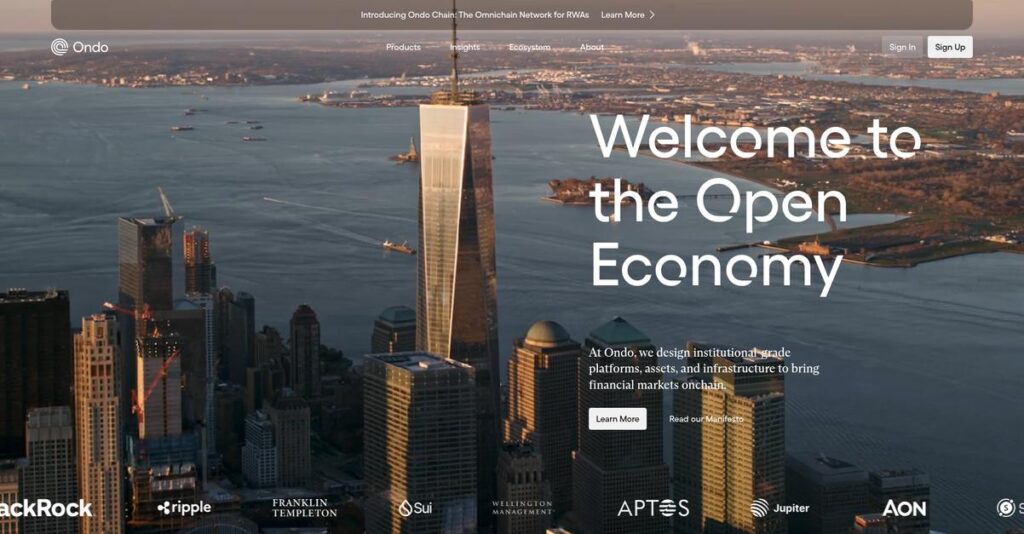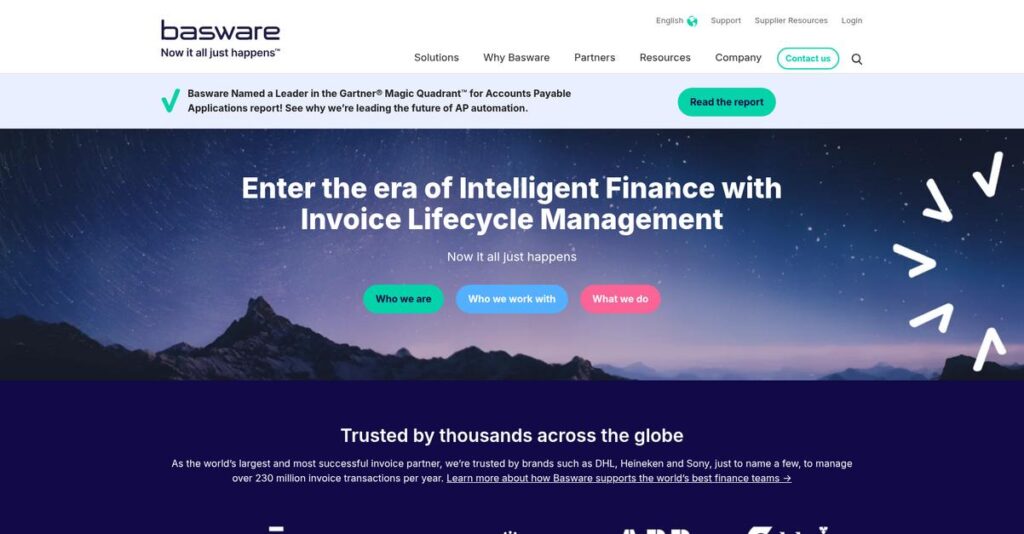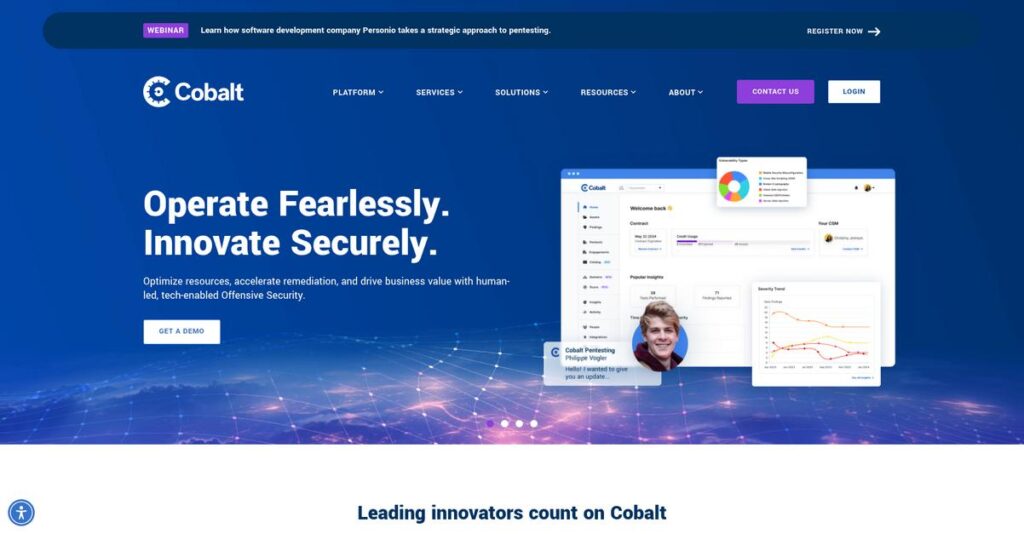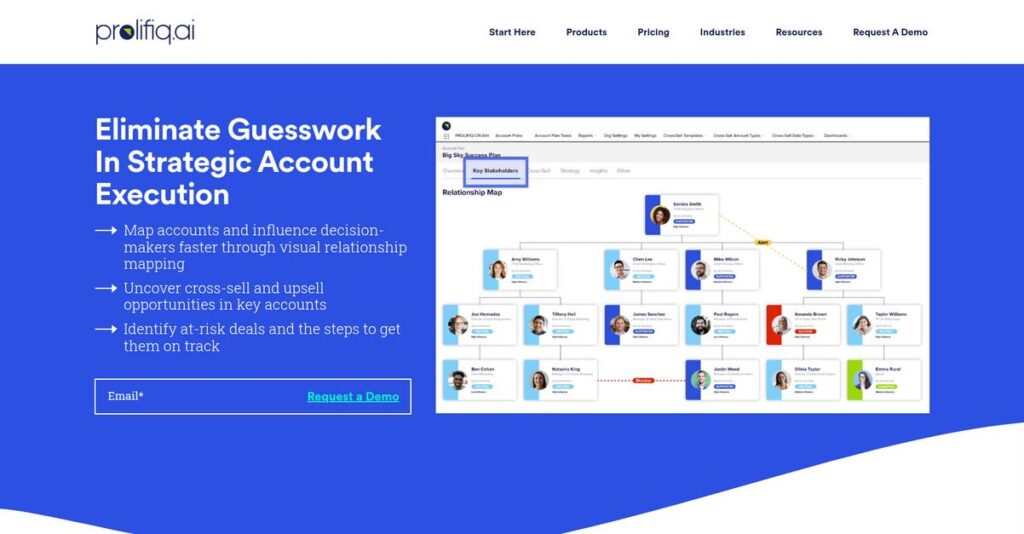Accessing real yield on blockchain is tough.
If you’re researching Ondo Finance, you’re likely tired of unstable or inaccessible DeFi yield options that don’t truly bridge to real-world assets.
The reality is, you’re missing out on reliable returns while sifting through overly complex, risky protocols that rarely deliver on their yield promises.
Ondo Finance tackles this by bringing tokenized US Treasuries, money market funds, and institutional-grade assets directly on-chain—letting you access regulated, diversified returns with features like overcollateralization and daily interest payouts.
In this review, I’ll break down how Ondo actually makes these real-world assets accessible to you and what makes them different from every other DeFi project promising yield.
You’ll get my complete Ondo Finance review, covering all the details: platform capabilities, key product comparisons (USDY, OUSG, OMMF, Flux Finance, and more), pricing, and what you should watch for before starting a free trial.
By the end, you’ll know the features you need to evaluate Ondo with confidence—and see if unlocking real yield through tokenized finance is actually for you.
Let’s dive into the analysis.
Quick Summary
- Ondo Finance is a platform that tokenizes real-world assets to provide institutional-grade on-chain exposure to US Treasuries and money market funds.
- Best for accredited investors and institutions seeking compliant, yield-bearing stable assets on blockchain.
- You’ll appreciate its focus on regulatory compliance and 24/7 liquidity for traditionally hard-to-access financial products.
- Ondo Finance offers fee-based asset products with no public free trial, requiring direct contact for institutional access.
Ondo Finance Overview
Ondo Finance is a US-based firm I’ve been tracking since its 2021 founding. Their mission is bringing institutional-grade financial products, like US Treasuries, directly onto the blockchain.
They primarily cater to institutional and accredited investors looking for reliable, on-chain yield from familiar sources. What really stands out is their focus on tokenizing low-risk, high-quality assets, a refreshing change from typical speculative crypto ventures.
- 🎯 Bonus Resource: If you’re also looking into broader ways to generate returns in crypto, my article on best cryptocurrency mining software covers effective strategies.
Their recent expansion into tokenized money market funds and a dedicated Ondo Chain shows clear ambition, which I’ll explore in detail through this Ondo Finance review.
Unlike competitors focused on uncollateralized private credit, Ondo provides direct, overcollateralized exposure to government securities. This creates a fundamentally lower-risk profile that feels built for cautious capital that rightly values security over unpredictable returns from other platforms.
You’ll notice they work with crypto-native funds, DAOs, and sophisticated global investors. These are groups that need to manage treasury assets with real-world trust and transparency on-chain.
From my analysis, their entire strategic focus is on building institutional trust and deep, reliable liquidity, which is crucial for real-world adoption. This approach directly answers the market’s clear demand for safer, regulated, and far more transparent on-chain investment options.
Now, let’s examine their core products.
Ondo Finance Features
Seeking stable, yield-generating crypto investments?
Ondo Finance features focus on bridging traditional finance with blockchain, making institutional-grade assets accessible. Here are the five main Ondo Finance features that can transform your on-chain portfolio.
- 🎯 Bonus Resource: While we’re discussing various types of software, understanding best fire department software is equally important for specialized operations.
1. USDY (US Dollar Yield)
Tired of stablecoins with no yield?
Traditional stablecoins offer stability but often leave your capital sitting idle. This means you miss out on potential earnings from your digital assets.
USDY provides a tokenized note backed by short-term US Treasuries and bank deposits, offering a variable interest rate. From my testing, its daily calculated APY, currently around 4.29-5.30%, is a compelling feature for non-US investors. While there’s a 40-50 day transferability delay, it’s overcollateralized for security.
What you get is a stablecoin alternative that actually puts your idle funds to work, enhancing your crypto holdings.
2. OUSG (US Treasuries Fund)
Want low-risk, liquid on-chain exposure to US Treasuries?
Accessing US Treasuries on-chain can be complex and illiquid for many investors. This limits your ability to diversify your digital assets effectively.
OUSG offers liquid exposure to short-term US Treasuries, primarily through BlackRock funds, with 24/7 instant mints and redemptions. This feature is tailored for qualified and accredited institutional investors seeking stable, low-risk on-chain yield, a real game-changer. It also serves as robust collateral on DeFi platforms like Flux Finance.
So as an institutional investor, you can easily integrate traditional safe-haven assets directly into your DeFi strategies.
3. OMMF (Tokenized Money Market Fund)
Need a stable, yield-bearing token for collateral and settlement?
Finding a stablecoin that offers yield while maintaining strict price stability for collateral and OTC trading is challenging. This can hinder efficient capital utilization.
OMMF is a token that lets global stablecoin holders invest in tokenized US money market funds, minting and redeeming for exactly $1 daily. What I love about this approach is how interest is distributed daily as new tokens, ensuring price stability, which is a key feature. It’s ideal for settlement and collateral on lending protocols.
This means you can leverage your stablecoins in a way that generates yield without compromising their use in trading or lending.
4. Flux Finance
Looking for a secure, overcollateralized DeFi lending platform?
Many decentralized lending protocols can expose you to excessive risk with volatile collateral. This often makes secure borrowing and lending a constant worry.
Flux Finance, forked from Compound V2, enables overcollateralized lending and borrowing with high-quality collateral like OUSG. This is where Ondo gets it right; it allows retail investors to indirectly access yield by lending non-yield stablecoins, a smart feature. The protocol is governed by the Ondo DAO, adding a layer of community oversight.
The result is your team gets a more secure lending environment, minimizing risk while still enabling yield opportunities.
5. Ondo Global Markets
Dreaming of on-chain access to diverse traditional assets?
Limiting your on-chain portfolio to just crypto or tokenized Treasuries can restrict diversification. This means you might miss out on broader market opportunities.
Ondo Global Markets aims to provide on-chain access to thousands of tokenized traditional stocks, bonds, and ETFs. This platform differentiates itself by enabling smart contract compatibility and on-chain settlement, a powerful set of features. It allows for diversification beyond existing tokenized assets, catering to evolving investor needs.
This means you can finally expand your digital asset portfolio into a vast array of traditional securities, all on the blockchain.
Pros & Cons
- ✅ Offers institutional-grade tokenized real-world assets with consistent yield.
- ✅ Provides 24/7 liquidity for on-chain US Treasuries and money market funds.
- ✅ Focuses on robust security, overcollateralization, and regulatory compliance.
- ⚠️ Most products are restricted to qualified purchasers and accredited investors.
- ⚠️ KYC/AML requirements can be a barrier for some decentralized finance users.
- ⚠️ USDY has an initial transferability delay, impacting immediate liquidity for some.
These Ondo Finance features work together to create a robust ecosystem for tokenized real-world assets, offering a new frontier for investors seeking stability and yield.
Ondo Finance Pricing
How much will this actually cost you?
Ondo Finance pricing follows a custom quote model, primarily through fee-based tokenized asset offerings, meaning you’ll need to contact them directly for detailed cost information.
Cost Breakdown
- Base Platform: Custom quote; fee-based for minting/redeeming assets
- User Licenses: Not applicable (tokenized asset model)
- Implementation: Not publicly disclosed; likely included in asset fees
- Integrations: Varies by complexity and institutional needs
- Key Factors: Asset type (USDY, OUSG), transaction volume, institutional access
1. Pricing Model & Cost Factors
Understanding their pricing model.
Ondo Finance’s revenue primarily stems from its tokenized asset offerings, like USDY and OUSG, where costs are embedded within the asset’s structure, such as fund expenses. For OUSG, expenses are capped at 0.15%, with management fees waived until October 2025. Your specific costs depend on the assets you engage with and your investment volume.
From my cost analysis, this means your financial outlay is directly tied to your investment activity in their tokenized products.
2. Value Assessment & ROI
Is this worth your investment?
Ondo Finance offers access to institutional-grade yield through blockchain, potentially offering better returns than traditional stablecoins, as seen with USDY’s variable APY. This structure allows you to access stable, yield-generating real-world assets on-chain, converting traditional financial value into crypto-native utility.
- 🎯 Bonus Resource: If you’re also looking into specialized operations software, my article on uncomplicate your ops covers crucial insights.
From my cost analysis, the result is your budget gains exposure to unique, potentially higher-yield opportunities not typically found in DeFi.
3. Budget Planning & Implementation
Planning for your total cost.
While specific pricing isn’t transparent, the costs for products like USDY and OUSG are integrated into their yield structure and fund expenses. For institutional investors, this means considering minimum investment amounts, such as $500 for USDY or over $100,000 for wire transfers, alongside any on-chain gas fees for transactions.
So for your budget, factor in the direct costs associated with asset management and any related transaction fees for a clear total cost of ownership.
My Take: Ondo Finance’s pricing is embedded within its tokenized products, making it suitable for investors seeking on-chain exposure to real-world assets with transparent, yield-related costs rather than traditional subscriptions.
The overall Ondo Finance pricing reflects asset-based value rather than a typical software subscription.
Ondo Finance Reviews
What do real customers actually think?
Analyzing Ondo Finance reviews reveals a consistent pattern: users value its innovative bridge between traditional finance and DeFi, though accessibility remains a key discussion point.
1. Overall User Satisfaction
Users seem generally positive.
From my review analysis, general sentiment suggests a positive reception for Ondo’s efforts in bringing TradFi on-chain. What I found in user feedback is that users appreciate the consistent yield generation and institutional-grade approach, which builds confidence in the platform’s reliability.
This means you can expect a platform focused on security and stable returns.
2. Common Praise Points
Access to real-world assets truly resonates.
Users consistently praise the ability to access traditional financial instruments like US Treasuries and money market funds through blockchain technology. Review-wise, the 24/7 liquidity is a significant advantage over traditional markets, offering unprecedented flexibility for investors seeking yield.
This suggests you’ll benefit from consistent yield and high liquidity for your assets.
- 🎯 Bonus Resource: While we’re discussing digital assets and platforms, you might find my analysis of best 3D painting software helpful for unifying your creative assets.
3. Frequent Complaints
Accessibility restrictions are a frequent gripe.
Many of Ondo’s products, particularly OUSG and OMMF, are restricted to qualified purchasers and accredited investors, limiting general retail access. What stands out in customer feedback is how KYC/AML requirements can be a barrier, especially for those used to the more anonymous aspects of DeFi.
These limitations mean your eligibility will determine which products you can access.
What Customers Say
- Positive: “Finally, a way to get real-world asset exposure and yield directly on-chain. Game-changer.”
- Constructive: “Wish more products were open to regular retail investors, not just accredited ones.”
- Bottom Line: “Great for institutional-grade access to Treasuries, but KYC can be a hurdle.”
The overall Ondo Finance reviews reflect strong appreciation for its innovation, despite clear limitations in accessibility for some users.
Best Ondo Finance Alternatives
Which Ondo Finance alternative is right for you?
The best Ondo Finance alternatives offer distinct strengths, each aligning better with specific RWA tokenization needs, risk appetites, and target assets.
1. Securitize
Seeking broader tokenized private equity and funds?
Securitize excels if you prioritize a wider range of tokenized private equity and fund shares, or a platform with a larger, established asset base in the RWA market. What I found comparing options is that Securitize’s BlackRock partnership offers significant scale in the U.S. Treasury RWA market.
Choose this alternative for a more expansive asset selection, especially with institutional backing and broader asset types.
- 🎯 Bonus Resource: While we’re discussing selecting the right platforms, understanding how to elevate your accuracy with medical transcription software is equally important.
2. Centrifuge
Focused on private credit and illiquid debt tokenization?
Centrifuge is ideal if your primary interest lies in private credit and illiquid debt tokenization, particularly for small and medium-sized businesses seeking alternative financing. From my competitive analysis, Centrifuge specializes in niche, illiquid debt assets, offering unique access compared to Ondo’s liquid focus.
Consider Centrifuge if you’re a business seeking or providing credit against diverse, non-traditional real-world assets.
3. Maple Finance
An institution seeking uncollateralized DeFi lending?
Maple Finance makes sense if you are an institution looking for uncollateralized lending and borrowing opportunities within the DeFi space. What I found comparing options is that Maple Finance caters specifically to institutional uncollateralized loans, presenting a different risk model than Ondo’s overcollateralized approach.
Choose Maple Finance when your institutional strategy involves providing or accessing uncollateralized capital pools in DeFi.
4. Goldfinch
Interested in lending to real-world businesses without crypto collateral?
Goldfinch is a suitable choice if you’re interested in providing capital to real-world businesses and earning yield without requiring crypto collateral. Alternative-wise, Goldfinch enables broader access to credit for businesses by removing the crypto collateral barrier, a unique differentiator from Ondo.
Go with Goldfinch if your goal is to support and earn from real-world business lending directly, not tokenized securities.
Quick Decision Guide
- Choose Ondo Finance: Accessing liquid, low-risk, tokenized US Treasuries and money markets
- Choose Securitize: Broader private equity tokenization and large asset scale
- Choose Centrifuge: Specializing in illiquid private credit for SMEs
- Choose Maple Finance: Institutional uncollateralized lending and borrowing needs
- Choose Goldfinch: Providing capital to real-world businesses without crypto collateral
The best Ondo Finance alternatives truly depend on your specific RWA investment goals and risk tolerance, not just features.
Ondo Finance Setup
Is Ondo Finance setup a complex undertaking?
An Ondo Finance review shows its implementation centers on a stringent onboarding process for institutional-grade products. This section sets realistic expectations for your deployment journey.
1. Setup Complexity & Timeline
This isn’t an instant onboarding.
The setup for Ondo Finance involves strict KYC/AML screening and, for institutional clients, signing subscription documents. From my implementation analysis, the initial issuance of USDY tokens can have a 40-50 day transferability delay, requiring significant upfront planning.
You’ll need to budget time for compliance checks and document processing before full access.
2. Technical Requirements & Integration
Expect specific blockchain compatibility and wallet needs.
Your team will require a compatible DeFi wallet to store tokens and interact with the platform across various blockchain networks. What I found about deployment is that smart contracts for trading or lending must pass compliance review for whitelisting requirements.
Plan for your IT team to ensure wallet compatibility and smart contract readiness across chosen networks.
- 🎯 Bonus Resource: While we’re discussing compliance and preventing risks, you might find my guide on best safety management software helpful for broader operational security.
3. Training & Change Management
User adoption requires some blockchain familiarity.
While the UI is likely user-friendly, understanding tokenized assets, yield mechanisms, and DeFi protocols requires some blockchain knowledge. From my analysis, successful change management depends on user education regarding tokenized real-world assets and associated protocols like Flux Finance.
Invest in educational resources and documentation to help your team navigate new concepts around on-chain assets.
4. Support & Success Factors
Vendor support is available for critical requests.
Ondo Finance emphasizes client service and provides support via email for investment and redemption requests exceeding instant limits. From my analysis, their commitment to client service is a key success factor, especially for institutional operations that require responsive assistance.
Ensure clear communication channels are established with Ondo’s support team for critical operational requests and troubleshooting.
Implementation Checklist
- Timeline: Weeks to months due to compliance and transfer delays
- Team Size: Legal/compliance, finance, and technical staff
- Budget: Professional services for legal and technical integration
- Technical: Compatible DeFi wallet and smart contract compliance
- Success Factor: Thorough KYC/AML and blockchain familiarity
The overall Ondo Finance setup requires meticulous compliance and technical preparation but offers access to innovative tokenized assets.
Bottom Line
Is Ondo Finance the right investment for you?
My Ondo Finance review indicates a powerful bridge between traditional finance and DeFi, ideal for specific institutional and accredited investors seeking yield-bearing, compliant on-chain assets.
1. Who This Works Best For
Investors bridging TradFi and DeFi.
Ondo Finance works best for institutional investors, accredited individuals, and non-US entities seeking compliant, yield-bearing exposure to US Treasuries and money market funds on-chain. What I found about target users is that protocols integrating regulated real-world assets for collateral or other financial primitives also benefit.
You’ll see significant value if your goal is stable, institutional-grade on-chain yield with strong regulatory adherence.
2. Overall Strengths
Unlocking institutional-grade, yield-bearing on-chain assets.
The software succeeds by tokenizing highly liquid US Treasuries and money market funds, offering consistent yield and 24/7 accessibility within a compliant framework. From my comprehensive analysis, its focus on regulatory compliance instills confidence for institutional adoption, a key differentiator in the DeFi space.
These strengths directly translate into secure, reliable, and accessible on-chain exposure to traditional financial instruments for your portfolio.
3. Key Limitations
Accessibility restrictions narrow the immediate audience.
While powerful, many of Ondo’s core products are restricted to qualified purchasers and accredited investors, with USDY unavailable in the US. Based on this review, retail investors in the US will find limited direct access to its flagship tokenized assets due to these requirements.
I’d say these limitations are significant for a broad retail audience, but manageable trade-offs for its intended institutional and accredited users.
4. Final Recommendation
Ondo Finance earns a strong recommendation for its target market.
You should choose this software if you’re an eligible institution or investor looking for regulated, high-quality, real-world assets integrated into your on-chain strategy. From my analysis, your success depends on meeting the accreditation requirements and needing compliant, yield-generating stable assets.
My confidence level is high for institutional and accredited investors but drops for general retail users in restricted regions.
Bottom Line
- Verdict: Recommended for institutional and accredited investors
- Best For: Institutions, accredited investors, and non-US entities seeking RWA exposure
- Business Size: Primarily larger investors and financial institutions
- Biggest Strength: Compliant, yield-bearing tokenized US Treasuries and money market funds
- Main Concern: Accessibility restrictions for retail and US investors
- Next Step: Explore USDY or inquire about OUSG eligibility
This Ondo Finance review highlights strong value for the right investor profile, while also acknowledging important accessibility considerations before you decide.
- 🎯 Bonus Resource: While we’re discussing compliance and user experience, understanding how to impact visitors with efficient solutions is also key.





